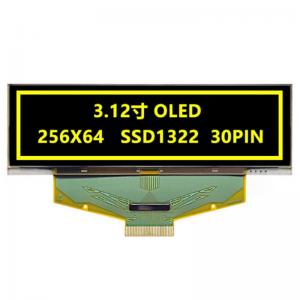

Add to Cart
3.12 inch OLED Display Module, 3.12" 256*64 Dots Oled Display Module Introduction
The Organic Light-Emitting Diode (OLED) is a new generation technology, brighter and clearer images with more agile responding speed. This OLED 3.12" inch model no. SFOS312YZ-7091AN OLED display is made of 256 x 64 dots individual mono color. This OLED module is lightweight, low power and small, there are different interfaces optional; it is default SPI, Parallel and I2C interface.
The size of the active area is 3.12” diagonal with module dimension
88.00 (W) x27.80 (H) mm, active area dimension 76.78 (W) x 19.18
(H) mm. This 3.12 inches OLED display has built-in IC SSD1322 and
boasts high contrast ratio 20,000 : 1. Logic supply voltage ranges
from 2.4V-2.6V, the typical value is 2.5V. It is great for the
application such as medical device, POS system, white goods, home
applications, industrial instrument, automation, audio/visual
display systems, personal care appliances, household goods,
automobile displays, Dynamic information displays etc.
Features
| Product: | 3.12" Inch Passive OLED | Resolution: | 256x64 Pixels Resolution |
|---|---|---|---|
| Display Mode: | Passive Matrix | Interface: | Parallel, SPI Optional |
| Display Color: | White, Yellow | Optics: | All Viewing Angles |
| Outline Dim.: | 88.00 (W) X27.80 (H) | Active Area: | 76.78 (W) X 19.18 (H) |
| Pixel Pitch: | 0.30 (W) X 0.30 (H) | Operating Temp: | -40°C To +80°C |
| Storage Temp.: | -40°C To +85°C | Driver IC: | SSD1322 |
| Supply Voltage: | 2.4 - 3.5V | Pin Number: | 30 Pins |
| Compliance: | REACH & RoHS Compliant | IC Package Type: | COF |
| Module Connecting Type: | ZIF | Duty: | 1/64 |
3.12" Inch 256x64 Pixels COF OLED Display Drawing
Absolute Maximum Ratings
| Parameter | Symbol | Min | Max | Unit |
Supply Voltage | VDD | -0.5 | 2.75 | V |
| VCC | -0.5 | 21 | V | |
| VDDIO | -0.5 | VCI | V | |
| VCI | -0.3 | 4 | V | |
| Operating Temperature | TOP | -40 | 85 | .C |
| Storage Temperature | TSTG | -65 | 150 | .C |
| Life Time (100 cd/m2) | 20,000 | - | hour | |
| Life Time (90 cd/m2) | 25,000 | - | hour | |
| Life Time (80 cd/m2) | 30,000 | - | hour |
Optics Characteristics
Characteristics | Symbol | Conditions | Min | Typ | Max | Unit |
Brightness (VCC Supplied Externally) | Lbr | Note 5 | 60 | 80 | - | cd/m2 |
| C.I.E. (White) | (x) (y) | C.I.E. 1931 | 0.25 0.27 | 0.29 0.31 | 0.33 0.35 | |
| Dark Room Contrast | CR | - | 2000:1 | - | ||
| Viewing Angle | 160 | - | - | degree |
DC Characteristics
Characteristics | Symbol | Conditions | Min | Typ | Max | Unit |
| Logic Supply Voltage | VDD | 2.4 | 2.5 | 2.6 | V | |
| Supply voltage for Operation | VCI | 2.4 | 2.8 | 3.5 | V | |
| Power Supply for I/O pins | VDDIO | 1.65 | VCI | V | ||
Operating voltage for OLED | VCC | Note 5 | 11.5 | 12 | 12.5 | V |
High Level Input | VIH | IOUT = 100μA, 3.3MHz | 0.8×VDDIO | - | VDDIO | V |
| Low Level Input | VIL | IOUT = 100μA, 3.3MHz | 0 | - | 0.2×VDDIO | V |
| High Level Output | VOH | IOUT = 100μA, 3.3MHz | 0.9×VDDIO | - | VDDIO | V |
| Low Level Output | VOL | IOUT = 100μA, 3.3MHz | 0 | - | 0.1×VDDIO | V |
| Operating Current for VCI | ICI | - | 95 | 120 | μA | |
| Operating Current for VCC | ICC | Note 6 | - | 34.5 | 40 | mA |
| Sleep Mode Current for VDD | IDD, SLEEP | Note 8 | - | 1 | 10 | μA |
| Sleep Mode Current for VDDIO | IDDIO, SLEEP | Note 8 | 1 | 10 | ||
Sleep Mode Current for VCI | ICI, SLEEP | Note 8 | - | 2 | 50 | μA |
3.12" Inch 256x64 Pixels COF OLED Display Product Image
